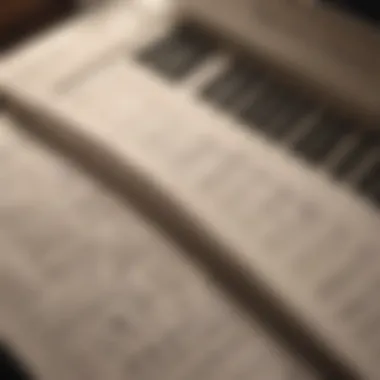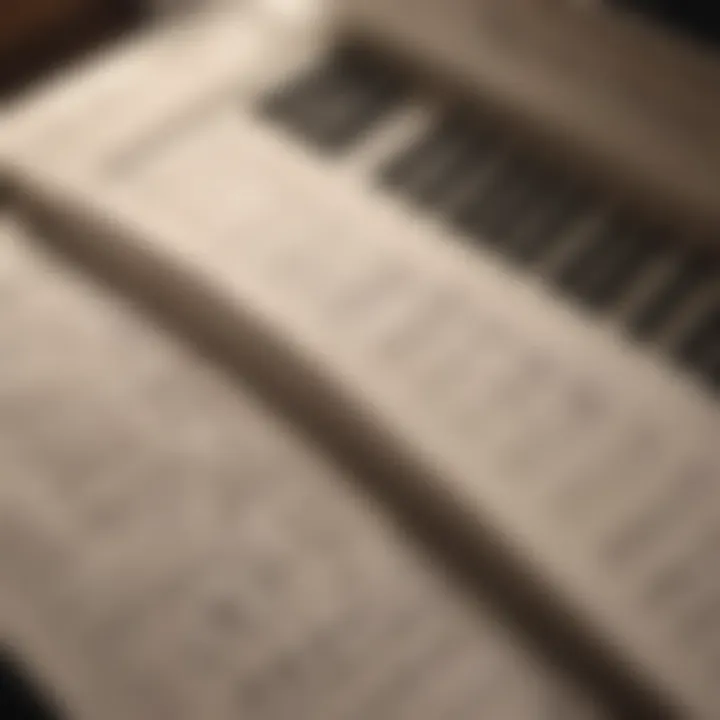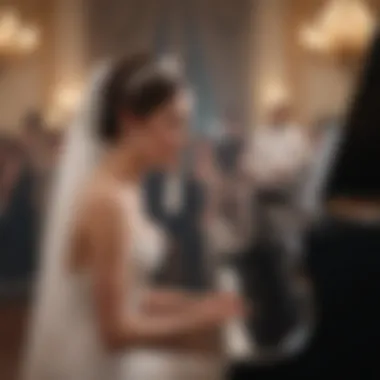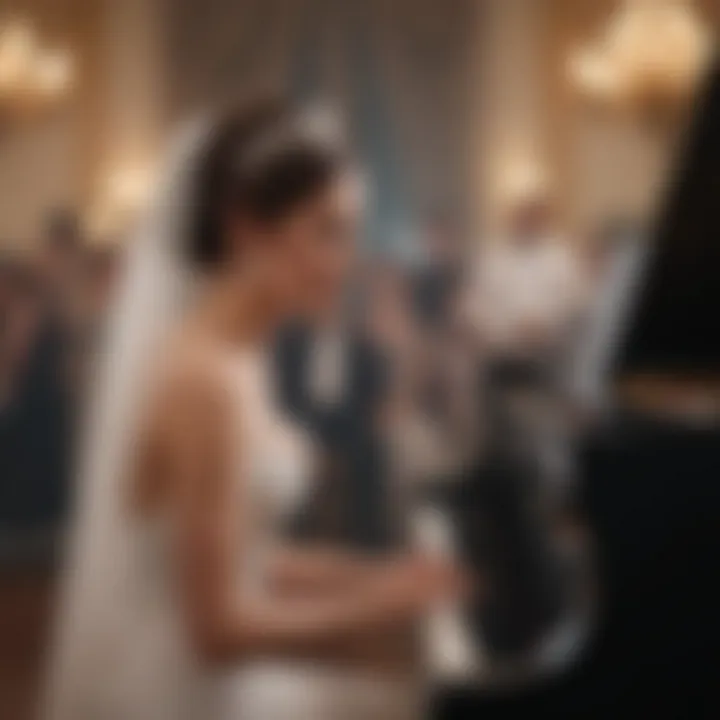The Musical Significance of 'Here Comes the Bride'


Intro
The piece known as 'Here Comes the Bride' has transcended its origins to become a significant component of wedding ceremonies worldwide. Its melodic simplicity and emotional depth resonate with many, making it a staple in the world of wedding music. Understanding its musical significance involves a look into its historical roots, the intricacies of its composition, and its cultural impact over the years. This exploration serves not only musicians but also anyone interested in the traditions surrounding matrimonial events.
Artist Profile
Biography and Background
While the piece is often attributed to Richard Wagner, it is important to clarify that it originated from his 1842 opera Lohengrin. Wagner was a prominent German composer known for his contributions to the operatic genre. He was born in Leipzig and showed musical aptitude from a young age. Over time, Wagner became known for his innovative use of harmony and orchestration. His works, including Lohengrin, not only influenced music but also the broader cultural landscape of Europe.
Major Influences and Inspirations
Wagner's compositions were heavily influenced by Romantic ideals. His desire to create a comprehensive art form that combined music, poetry, and drama can be seen throughout his work. Other composers of his era, like Ludwig van Beethoven and Franz Liszt, also shaped his approach to music. The emotional intensity and narrative depth of Wagner's operas reflect a shift towards a more expressive musical language that demonstrates the connections between storytelling and music.
Song Analysis
Theme and Lyrics Breakdown
Although 'Here Comes the Bride' is primarily known for its melody,its thematic elements are intertwined with the ideas of love and union. The lyrics, while not always publicly sung, convey sentiments of hope and new beginnings. The music evokes emotions associated with the anticipation of a wedding, encapsulating joy and unity.
Instrumentation and Composition
The original orchestration by Wagner is rich yet straightforward. The composition employs a blend of brass and strings, creating an uplifting sound. It starts simply and builds across its progression, encouraging a sense of grandeur. Piano adaptations often simplify orchestration further while retaining emotional essence.
The chord structure typically follows a major key, which enhances the joyous and celebratory feeling associated with weddings. This choice of tonality plays a crucial role in its enduring appeal. When played on the piano, musicians often include variations that embellish the melody, making the piece uniquely their own. This flexibility in interpretation allows 'Here Comes the Bride' to adapt to various performance settings, from intimate gatherings to grand ceremonies.
"The simplicity of the melody combined with its rich emotional context makes 'Here Comes the Bride' a timeless choice for weddings."
In summary, 'Here Comes the Bride' embodies a blend of historical significance, emotional depth, and musicality that has allowed it to endure as a cultural icon. Its relevance in modern wedding customs is undeniable, making it an essential piece for both musicians and audiences.
Historical Background of 'Here Comes the Bride'
The historical background of "Here Comes the Bride" is vital for understanding its musical significance. This section delves into the origins, compositional development, and cultural context of the piece. The exploration not only illuminates how it has become a staple in wedding ceremonies but also how it reflects broader musical and social trends over time. The implications of its background inform its use today, showing how deeply intertwined music and culture can be.
Origin of the Piece
The piece known today as "Here Comes the Bride" originates from the opera Lohengrin, composed by Richard Wagner in 1850. The bridal chorus is performed in Act III as the character Elsa walks to her wedding. Despite its operatic roots, the piece quickly transcended its initial context and became associated exclusively with weddings. Interestingly, it wasn't until the late 19th century that it gained popularity as a wedding march in English-speaking countries. The emblematic nature of the melody, combined with its operatic origin, adds depth to its significance.
Compositional History
Wagner's composition contributes to the piece's unique character. Wagner employed a rich harmonic language and vivid orchestration, creating a sense of grandeur that perfectly complements the ceremony it often accompanies. The chorus was not originally intended for solo piano, but its arrangement for piano has enabled it to blossom in a variety of performances. As musicians adapted the piece for solo performance, embellishments and variations emerged, influencing how it is understood and played today. There are multiple arrangements, showcasing different interpretive choices based on the performer’s preferences.
Cultural Context
The cultural context surrounding “Here Comes the Bride” is crucial. As weddings evolved into significant public ceremonies, the need for a musical identity grew. The bridal chorus provided not only a musical backdrop but also signified the transition from single life to married life. It reflects societal norms and values around marriage that have changed over decades. Today, it embodies a timeless symbol of love and union, resonating across various cultures and adapting to contemporary practices. Its use varies across regions, showing how it has been localized while retaining its core identity as a wedding anthem.
In summary, this historical exploration establishes the foundation of "Here Comes the Bride" as a wedding piece. By examining its origins, compositional history, and cultural relevance, one can appreciate its status as more than just a melody—it is a musical representation of an important life milestone.
The Musical Composition
The musical composition of "Here Comes the Bride" is essential to understanding its continued legacy and impact. This piece's melody, harmony, rhythm, and overall structure create a unique sound that resonates with many. It serves not only as a musical exercise for performers but also as a reference point for analyzing how wedding music has shaped cultural practices.
Melody and Harmony


The melody of "Here Comes the Bride" is simple yet captivating. It presents a series of rising and falling notes, creating a sense of journey. This characteristic makes it easy for musicians to remember and play. The harmony, on the other hand, complements the melody perfectly, enhancing its emotional depth. Traditionally, the piece may use basic chords like C major and G major, but skilled performers often incorporate more complex harmonies for added richness.
Key points about melody and harmony:
- Memorability: The straightforward melody allows for easy recall.
- Emotional Impact: The harmony can elevate the overall mood.
- Adaptability: Musicians can change the chords to suit various styles.
Rhythm and Tempo
The rhythm of "Here Comes the Bride" maintains a steady and solemn pace that is appropriate for wedding ceremonies. Typically performed in a moderate tempo, the piece can vary based on the performer’s interpretation. Faster renditions may evoke excitement but can detract from the gravitas of the moment.
Understanding the rhythm is crucial during performances. The steady pulse enables musicians to convey the solemnity expected during a wedding procession. Additionally, some variations allow for subtle shifts in rhythm, giving the performer room to express their personal style.
Considerations about rhythm and tempo:
- Tempo Choices: The average tempo often sits around 60-76 beats per minute.
- Expressiveness: Slight variations can showcase the musician's feelings.
- Cultural Interpretations: Some cultures may prefer different pacing to align with ceremonial traditions.
Structural Analysis
The structure of "Here Comes the Bride" adheres to a recognizable pattern that is easy to analyze. Typically, it follows a straightforward A-B-A format, where the initial section presents the main theme, followed by a contrasting section that retains core elements of the original melody. This approach allows for both familiarity and variety.
Performers can manipulate this structure while retaining the essence of the piece. This flexibility encourages various interpretations, from classical arrangements to modern adaptations. Musicians have room to develop their creativity without losing the piece’s identity.
"The structured yet flexible nature of this piece makes it a favorite among performers of different styles."
Significant structural points:
- A-B-A Format: Familiarity aids accessibility for performers and listeners.
- Interpretive Freedom: Musicians can explore creativity while preserving the source material.
- Cultural Versatility: The structure allows adaptations suitable for diverse musical traditions.
Overall, the musical composition of "Here Comes the Bride" invites a depth of exploration, ranging from technical analysis to personal interpretation. Understanding these elements prepares musicians to engage more meaningfully with this timeless piece.
Use in Ceremonies
The piece 'Here Comes the Bride' holds a notable place in various ceremonies, particularly in weddings. Its usage extends beyond mere music; it signifies a transition and evokes emotions tied to significant life events. The incorporation of this anthem in ceremonies reflects cultural values, traditions, and the universal themes of love and commitment.
Traditional Weddings
In traditional weddings, 'Here Comes the Bride' is predominantly performed as the bride walks down the aisle. This moment is often filled with anticipation and joy, setting a noteworthy tone for the entire event. The music complements the visual grandeur of the ceremony, reinforcing the emotional weight of the moment. Many brides choose this piece for its familiarity and sentimental value.
The selection of this piece can influence the atmosphere of the wedding. The solemnity of the melody creates an air of dignity, while its melodious flow resonates with both guests and participants. Importantly, different cultures may interpret the use of this composition distinctively, yet its core representation of bridal beauty and promise of a new beginning remains consistent.
Variations Around the World
Around the globe, adaptations of 'Here Comes the Bride' are common. As cultures infuse their own identities into the piece, variations emerge. In some locations, such as in regions of Germany, the piece is often replaced or accompanied by local folk music that serves a similar purpose. Each locale's interpretation offers a unique twist on the original, reflecting diverse ceremonies while maintaining the essential celebration of unity.
These variations often involve alterations in orchestration or melody arrangements. Some might opt for a more classical rendition, while others may jazz it up for a lively wedding reception. These modifications allow the core emotion tied to 'Here Comes the Bride' to remain intact while integrating local traditions and colors.
Contemporary Adaptations
With the rise of modern music trends, 'Here Comes the Bride' continues to be reimagined. Contemporary adaptations can be observed in various wedding playlists and performances. Musicians now interpret this classic piece in different styles, ranging from pop and rock to electronic music, making it appealing to newer generations.
Many artists produce cover versions that maintain the essence of the original while introducing fresh elements. The emotional resonance of the music remains central, even as the execution may veer into new artistic territories. Couples seeking to personalize their ceremonies have many options at their disposal by exploring such adaptations.
In summary, the usage of 'Here Comes the Bride' in ceremonies is multifaceted. Its traditional role in weddings ensures that it maintains relevance. Variations from around the world and contemporary adaptations collectively enrich the musical landscape, allowing each couple to express their unique story through this timeless composition.
Piano Performance Techniques


Understanding piano performance techniques is vital for effectively conveying the essence of 'Here Comes the Bride'. Mastering these techniques can significantly enhance how a pianist interprets and expresses the emotions tied to this iconic piece. Learning specific performance methods opens avenues for musicians to connect with their audience and deliver more captivating renditions.
Basic Techniques for Beginners
For those new to playing 'Here Comes the Bride', starting with foundational skills is essential. Key elements to focus on include:
- Proper Hand Position: Keeping wrists relaxed and fingers curved is important to avoid strain.
- Fingering: Proper fingering will facilitate smoother transitions between notes. Beginners should practice the piece slowly to become familiar with note sequences.
- Dynamics: Understanding volume control can help a beginner bring life to the performance. Playing softer during delicate sections and louder during the climax adds depth.
Many resources are available, such as tutorials on YouTube, that provide visual guidance for beginners in their practice.
Intermediate and Advanced Techniques
As pianists progress to more advanced levels, they should explore additional techniques. Here are some crucial aspects for intermediate and advanced players:
- Voicing: This technique involves emphasizing certain notes within chords. It helps in creating a full and rich sound, especially during the melodic lines of the piece.
- Pedaling: Mastering the use of the sustain pedal adds resonance and cohesion in phrases. Experiment with half-pedaling to blend notes smoothly.
- Tempo Variations: While maintaining the original tempo, slight changes can impart a personal touch. Accelerating in specific sections can evoke feelings of excitement and joy.
Incorporating these advanced techniques requires focused practice and patience.
Expressive Playing Methods
Expressive playing is where the musician’s interpretation shines. Several methods can enhance expressiveness in 'Here Comes the Bride':
- Rubato: This technique allows for slight deviations in tempo to convey emotion. This could involve lingering on particular notes or phrases to add drama.
- Articulation: Clear distinctions between staccato and legato notes can affect the overall mood. Staccato notes can add brightness, while legato passages produce a flowing sound.
- Phrase Building: Understanding the structural phrases within the music can aid in shaping dynamics and emotions. Highlighting the climactic moments and gently releasing tension in quieter sections speaks volumes.
“Personal interpretation adds a unique character to each performance, inviting the audience into the musician’s emotional world.”
By diligently applying these techniques, pianists of all levels can breathe life into 'Here Comes the Bride', ensuring that each performance resonates profoundly with listeners.
Adaptations by Various Artists
The idea of adaptations by various artists plays a crucial role in understanding the musical significance of 'Here Comes the Bride.' Each reinterpretation encapsulates different cultural influences, technical evolutions, and individual artistic expression. Through such adaptations, the piece continues to evolve beyond its traditional context, allowing it to resonate with diverse audiences.
Classic Interpretations
Classic interpretations of 'Here Comes the Bride' often emphasize its romantic and grand qualities. Renowned composers and pianists have taken the basic melody and adorned it with intricate harmonies and elaborate arpeggios. For example, the version played by Franz Liszt transforms the simple tune into a complex piano composition, showcasing technical proficiency while remaining faithful to the original's sentiment.
Listeners appreciate these takes because they highlight the timeless nature of the piece. Some classic interpretations also infuse elements from their distinct cultural backgrounds. For instance, the arrangements by Arthur Sullivan add layers of depth, making them both respectful and innovative. Such renditions reinforce the piece's significance in the classical music canon while also shedding light on the creativity of the interpreters.
Modern Covers and Arrangements
In recent decades, modern covers of 'Here Comes the Bride' have emerged across various genres, including pop, rock, and jazz. Artists like Beyoncé and Vitamin String Quartet have offered refreshing renditions, bringing this traditional wedding march into contemporary settings. These adaptations often incorporate electronic elements or contemporary instrumentation, making the piece more accessible to younger audiences.
The growth of digital media facilitates these modern adaptations. Streaming platforms allow artists to share their interpretations widely, altering the way the music is perceived. Unlike traditional classical interpretations, modern covers appeal to an audience that values innovation and genre fusion. This reflects a shift in how wedding music is approached, showcasing flexibility and personalization in modern wedding celebrations.
Influences from Other Genres
Finally, the influence of 'Here Comes the Bride' extends beyond classical and modern adaptations. Cross-genre influences can be seen, particularly in film and television. Popular shows and movies have used the melody to evoke emotions in their narratives. Various composers incorporate 'Here Comes the Bride' subtly in scores to evoke themes of love and commitment.
In recent years, collaborations between genres have driven unique adaptations, blending elements of hip-hop with classical forms. Musicians are increasingly experimenting with tempo and rhythm to create distinct identities for the piece within different genres. This expansive view of the melody showcases its versatility and enduring relevance.
Each adaptation of 'Here Comes the Bride' is not simply an interpretation; it is a conversation between epochs, cultures, and musical styles, reminding us of the universal nature of love.
Through these adaptations, 'Here Comes the Bride' has secured a place not only in wedding ceremonies but also in the broader musical landscape, affirming its status as much more than a traditional wedding piece.
Cultural Impact


The cultural impact of "Here Comes the Bride" is vast. This piece not only functions as music for weddings but also serves as a cultural symbol across various societies. When played, it evokes emotions tied to love, commitment, and celebration. The significance of this piece extends beyond its melody; it represents a ritual that has shaped many marriage ceremonies. The familiarity of the tune helps communicate an important life event, marking the transition from single life to married life. Its prevalence in various celebrations underscores its status as a universal tune.
Role in Popular Culture
Within popular culture, "Here Comes the Bride" holds a unique position. It resonates in films, television, and even in viral internet clips. Many directors utilize this composition to signify weddings or matrimonial themes, establishing a recognizable audio cue that audiences immediately connect with love and commitment. Over time, its usage has evolved, appearing in parody and satire, further embedding it into the cultural consciousness. This piece's adaptability in soundtracks and performances highlights its ongoing relevance in modern media.
Symbolism and Interpretations
The symbolism associated with "Here Comes the Bride" varies by community. For some, it symbolizes the traditional pathway to marriage, rooted in historical customs. This piece often denotes purity and joy, embodying ideals such as love and loyalty. However, interpretations can also vary dramatically. In some contexts, it speaks to societal expectations around marriage. The melody can be perceived both as a celebration and as a commentary on the institution of marriage itself. Different regions might even assign unique meanings based on local beliefs and practices, reflecting their cultural heritage.
Responses from Different Communities
Different communities respond distinctly to "Here Comes the Bride." In Western cultures, it is predominantly linked to traditional weddings. However, in other societies, variations exist. Some communities have adapted the melody or have created alternatives that better reflect their traditions. The song can elicit strong responses; while some see it as a cherished component of their wedding ceremonies, others might question its relevance in contemporary relationships. These contrasting reactions highlight its complex position in the global cultural landscape.
Ultimately, "Here Comes the Bride" acts as a unifying musical presence in the multitude of cultural contexts surrounding marriage.
Contemporary Relevance
The contemporary relevance of "Here Comes the Bride" extends beyond its traditional role in wedding ceremonies. This piece has endured the test of time, weaving through modern wedding trends and digital interpretations while remaining a significant educational resource for aspiring musicians.
Modern Wedding Trends
In recent years, weddings have evolved to reflect personal values and unique stories. Traditional elements are being reinterpreted to align with contemporary aesthetics. The use of "Here Comes the Bride" is prevalent, but the way it is presented is often reimagined. Couples might opt for different arrangements to better suit their themes, whether that be a classical version played live or a modern cover played through digital streaming.
Furthermore, many weddings feature the piece in various forms, from orchestral versions to piano arrangements, complementing the mood of the day. This melodic tune continues to symbolize the moment a bride walks down the aisle, as it invokes emotions and memories tied to love and commitment.
Digital Adaptations
The rise of technology has transformed how music is consumed and performed. "Here Comes the Bride" has found its way into numerous online platforms. Digital adaptations can range from high-quality recordings to simplistic MIDI versions to cater to various preferences. On platforms like Spotify and YouTube, countless artists and musicians have uploaded their interpretations, making these versions widely accessible.
Social media also plays a role in how the piece is shared and experienced. From wedding videos on Facebook to TikTok dancing trends featuring the music, its presence in the digital world enhances its relevance. The ability to mix it into various genres further allows "Here Comes the Bride" to remain not just a wedding staple but a piece that transcends its initial purpose.
Education and Its Usage
For music students and enthusiasts, understanding "Here Comes the Bride" presents an opportunity to study various musical concepts, including melody, harmony, and phrasing. Its simplicity and familiarity make it an ideal piece for beginners, introducing essential skills in piano performance.
Music educators often include this piece in their curriculum to teach students the nuances of classical music. It can be broken down into smaller sections to help learners master techniques like dynamics and articulation. The song's rhythmic patterns are also beneficial for developing timing and precision.
The presence of this piece in the music education field further emphasizes its role in shaping future musicians. It builds a foundation not just for playing but for comprehension of music as a form of cultural expression.
Ultimately, "Here Comes the Bride" serves as more than just a wedding anthem; it remains deeply ingrained in both modern culture and educational practices, highlighting its lasting significance in today's society.
Culmination
The examination of 'Here Comes the Bride' underscores its multifaceted importance in both music and cultural settings. This traditional piece serves not only as a musical annotation during wedding ceremonies, but also as a reflection of historical and social changes over time. Through our exploration, we find that this piece encapsulates a variety of interpretations, integrating itself into the lives of listeners and performers alike.
Summary of Findings
The article's investigation revealed several key aspects:
- Historic Roots: 'Here Comes the Bride' has a rich background, linked to multiple cultural traditions and practices.
- Musical Elements: The musical composition showcases a simple yet profound melody, characterized by its harmonious blend of chords. The rhythm and tempo allow for both solemnity and celebration, adapting beautifully to different contexts.
- Ceremonial Role: Its use in weddings has cemented the piece's status, making it synonymous with bridal processions across the world.
- Adaptation and Influence: Various artists have interpreted this piece, contributing to its legacy and relevance through innovative arrangements spanning classical to contemporary genres.
- Cultural Resonance: Its symbolism extends beyond music, often representing love, hope, and unity in various communities.
These findings illustrate how 'Here Comes the Bride' is woven into the fabric of society, transcending the mere act of playing notes on a piano. The piece invites introspection and evokes a range of emotions, indicating its prominence in personal and shared experiences.
Future of 'Here Comes the Bride'
As we look ahead, the future of 'Here Comes the Bride' appears steadfast yet dynamic. It is likely to evolve further with changing cultural landscapes and technological advancements. For aspiring musicians, this presents a rich opportunity to explore new interpretations:
- Incorporation in Digital Media: With the rise of digital platforms, 'Here Comes the Bride' may find itself adapted in various contexts, including video games and films, thus reaching new audiences.
- Fusion with Modern Genres: Contemporary artists are expected to experiment with this classic piece, melding it with genres like pop, jazz, or electronic music, allowing it to resonate with younger listeners.
- Educational Use: As music education incorporates diverse materials, the piece may serve as a vital part of piano curricula, demonstrating both technical skill and emotional expression.
Through these developments, 'Here Comes the Bride' has the potential to maintain its significance while adapting to the evolving landscape of music, rendering it an enduring touchstone in both personal and communal celebrations.







